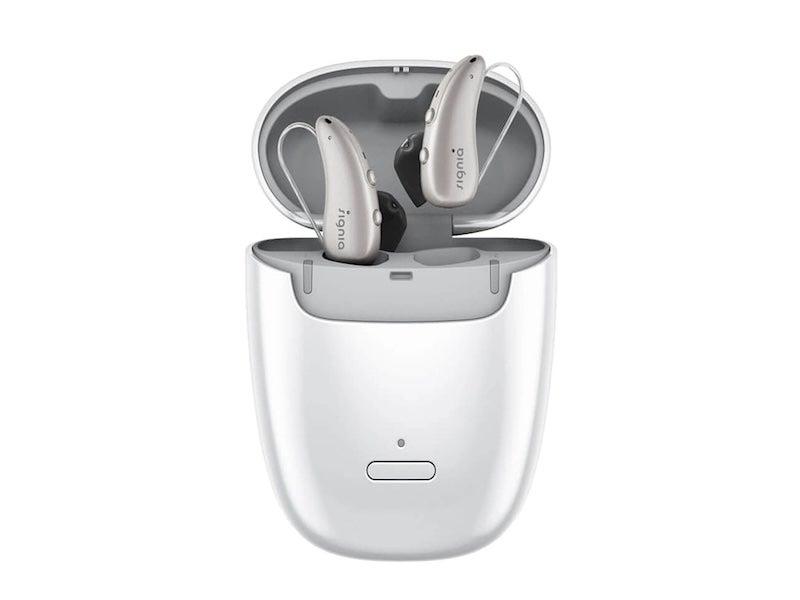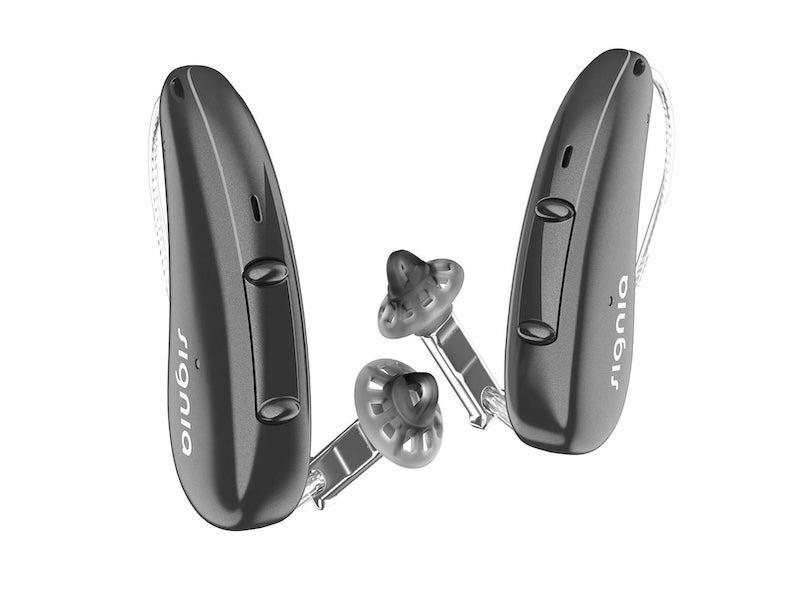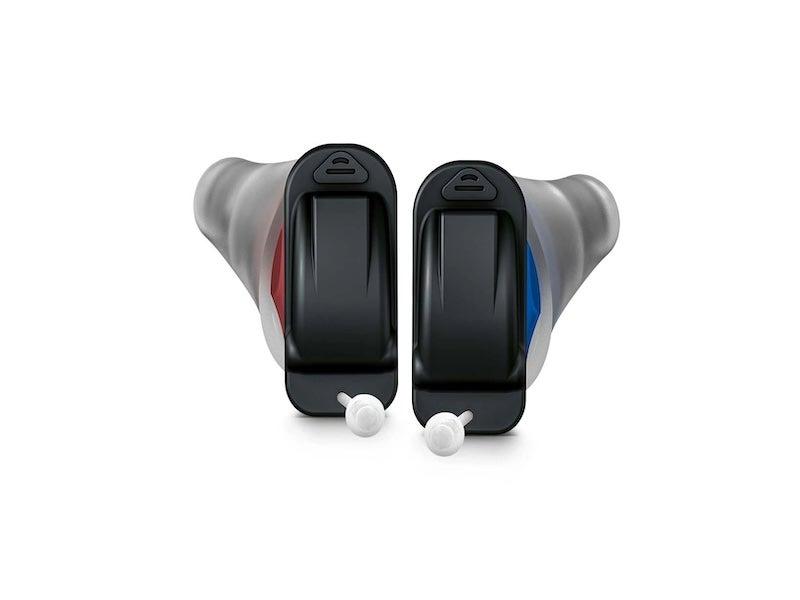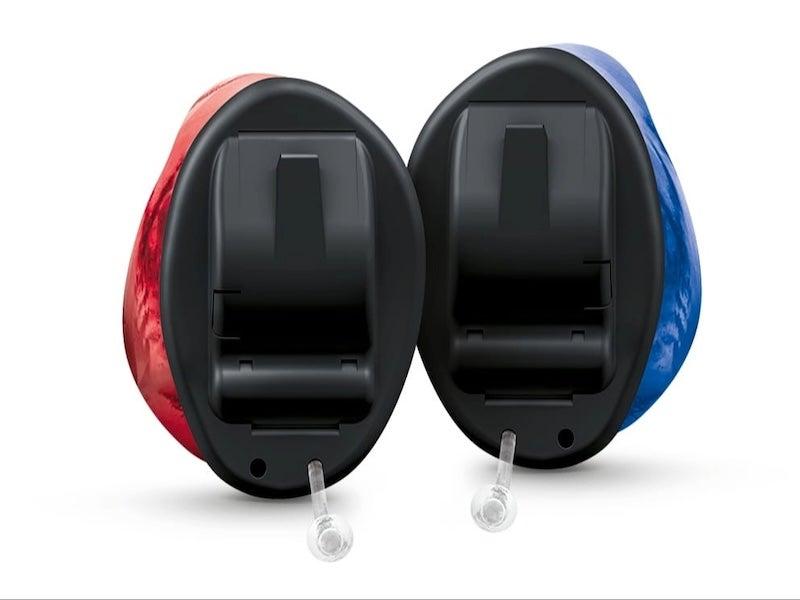Signia Hearing Aid Review 2025
This prescription-only brand uses smart technology to make Signia hearing aids feel as natural and comfortable as possible.

- Signia hearing aids are known for using technology to make wearing these devices feel as natural and comfortable as possible. The prescription-only brand offers a wide range of styles.
- The devices featured in this Signia hearing aid review range in cost from about $730–$3,109 per pair. For specific pricing, consult a hearing care professional who sells Signia hearing aids.
- Signia hearing aids use acoustic motion sensors to provide the most natural-sounding experience in settings where the wearer, the person talking, or both are moving.
- Signia has a lot of streaming options, but its connection may not be as stable as with other brands like Phonak hearing aids, especially on Android phones.
NCOA supports everyone’s right to age well. That’s why we test and recommend products we believe can help you live a healthier life. We’ve spent more than 5,000 hours researching hearing aids to give you the most accurate product reviews. To find the best hearing aids, we:
- Consulted with audiologists, hearing instrument specialists, and aging care experts
- Put more than 50 hearing aids through a series of 21 different tests
- Mystery shopped more than 20 brands
- Surveyed hundreds of older adults who use hearing aids
- Interviewed experts on hearing loss
- Sent hearing aids to our friends and family with hearing loss to provide long-term testing notes
- Read thousands of verified customer reviews
We’re constantly testing new hearing aids to give you the most accurate and up-to-date recommendations. Read more about our hearing aid review methodology.
Sound is a lot more than just volume. So when you’re looking for a hearing aid, you want it to do a lot more than just make noises louder. The best hearing aids can replicate a natural hearing experience. They can help focus on the sounds you want to hear (like a friend’s voice) and not other noise in the area (like the TV on in the background). Prescription hearing aid manufacturers are increasingly moving toward this goal. Signia hearing aids serve as a prime example.
Signia hearing aids are designed not just to optimize sound, but to make wearing hearing aids a pleasant experience. To that end, they include many helpful features like streaming audio, fitness tracking, and a discreet design. This Signia hearing aid review takes a closer look at Signia NX (natural Xperience), Xperience, AX (Augmented Xperience), and IX (Integrated Experience) lines.

22% of the respondents in our survey said they don’t like the sound quality of their hearing aids.1
—NCOA Hearing Aids User Survey
Why Signia is a top brand for prescription hearing aids
Signia is known for delivering high-quality sound processing and tech-forward features. Most of its hearing aids, including ITC models, feature Bluetooth or streaming capabilities. These devices can be customized through an app. Signia also uses motion sensors in its hearing aids. The motion sensors take into account how sound changes depending on the location of the person speaking and the person wearing the hearing aids. These sensors can help find a lost hearing aid and track the physical activity of the wearer (replacing the need for a traditional fitness tracker).
The Signia brand is an offshoot of Siemens Hearing Instruments. Its first prescription hearing aid was released around 2015. Signia continues to make high-quality, innovative hearing aids for people with mild to profound hearing loss. The most recent line, Signia IX, makes it easier to listen to group conversations, even in noisy settings.
Signia designs its hearing aids to fit the lifestyle of users. So they offer discreet designs, a variety of color and fit options, and a high IP rating for water and dust protection. With the added benefit of Bluetooth streaming and hands-free calling, Signia hearing aids do more than just enhance sound. They improve the experience of wearing hearing aids.
Comparing Signia hearing aids
| Comparison Features | ||||
|---|---|---|---|---|
| Hearing aid type | RIC, CIC, IIC, Earbud* |
RIC, ITE* |
RIC, BTE, ITE, Earbud* |
RIC, ITE, CIC |
| Battery type (disposable or rechargeable) | Rechargeable and disposable options |
Rechargeable and disposable options |
Rechargeable and disposable options |
Rechargeable and disposable options |
| Bluetooth | Yes, with Auracast |
Yes |
Yes |
Yes |
| Hands-free calling? | Yes |
Yes |
Yes |
Yes |
*RIC: Receiver-in-canal; CIC: Completely-in-canal; IIC: Invisible-in-canal; ITE: In-the-ear; BTE: Behind-the-ear
Understanding Signia hearing aid models
Shopping for prescription hearing aids is quite different from shopping for OTC hearing aids. With prescription aids, you have different platforms, which are like your computer’s operating system. The technology in these hearing aids can be very different, even if they look similar. Each technology platform may also offer certain features, which are often improved upon with the next update.
In this Signia hearing aid review, we take a closer look at the brand’s five most recent technology platforms: IX (Integrated Xperience), AX (Augmented Xperience), X (Xperience), and NX (Natural Xperience).
Signia IX: The Latest Flagship
The Signia IX makes it easier to follow group conversations where more than one person is speaking at a time. It can clarify speech even in noisy settings. Many IX models offer longer battery life, more charging options, and improved connectivity for streaming audio, calls, and music compared to Signia’s previous hearing aids.
Signia IX

- Enhanced speech-in-noise performance
- Real-time conversation enhancement
- Auracast-ready
- Type of hearing aid: RIC, CIC, IIC, Earbud
- Battery type: Rechargeable and disposable
- Bluetooth compatible: Yes, Auracast
Pros
- Can focus on multiple people speaking
- Longer battery life, even when streaming, plus on-the-go charging
- Work with multiple wireless and broadcast systems
Cons
- Cost is on the higher end of the range
- Not all models support all Bluetooth protocols or phones
- Relies heavily on app use
What’s different about IX
The Signia IX (Integrated Xperience) line is the brand's latest technology release. It features several key upgrades over previous models. The most notable upgrade is the IX's performance in group conversations. Using Signia's RealTime Conversation Enhancement technology, the IX enables the wearer to focus on multiple people speaking, mimicking natural hearing.
The IX features a new chip with a higher signal-to-noise ratio than other brands. This results in more precise sound with reduced background interference, so it performs better in noisy and outdoor environments. One study found that background noise made communication between hearing-impaired older adults and others more difficult. Using hearing aids that helped filter that noise improved communication.2
Other upgraded features on the Signia IX, like improved wind noise and echo reduction, also help. Like past lines, the IX uses motion sensor technology to adjust sound according to its source in relation to the hearing aids.
The IX line offers more features through the app, including activity tracking and tinnitus relief. Because the models in the IX line tend to be more compact, they have a discreet look. The IX line makes more models available with rechargeable options. Some designs also have longer battery life, on-the-go charging, and wireless charging.
The IX line is Signia’s first Auracast-ready line, which means it can stream audio in public venues equipped with the technology. “Auracast is the future of connectivity,” said Caroline Zuck, an audiologist with the Savannah Speech and Hearing Center in Savannah, Georgia. “Imagine being able to connect to a speaker in a crowded presentation via your phone, or connecting directly to a television and hearing the sound directly in your ears. This technology will be particularly helpful for people with a more severe hearing loss or people who struggle in background noise.” IX is also compatible with other wireless networks, including MFi, ASHA, LE Audio, and Bluetooth Classic.
Signia’s most advanced line makes it easier than ever to hear speech, even in conversations with multiple people speaking or noisy locations. The IX line also improves upon Signia’s existing technology for streaming audio and directional speech. And it has the same great app features and interface.
Signia AX: Outstanding Speech Clarity
The Signia AX or Augmented Xperience platform is the first to use separate channels to process speech and background noise for clearer sound. It also features a more efficient chip. So setting adjustments are smoother for a more natural-sounding listening experience.
Signia AX

- Clearer sound in noisy places
- Advanced acoustics adapt to changing noise levels more quickly
- Improved wind noise and echo reduction
- Type of hearing aid: ITE, RIC
- Battery type: Rechargeable and disposable options
- Bluetooth compatible: Yes
Pros
- The ITE option can stream Bluetooth and charge wirelessly
- Prioritizes speech in noisy settings
- New feature in the app allows for wellness tracking (You can track physical fitness, wear time, and more using your hearing aids)
Cons
- Not Auracast-ready
- Only two styles, no ITC option
- Hands-free calling only works on iOS (Apple smartphones)
What’s different about the Signia AX
The Signia Augmented Xperience (AX) line is the second-newest from the brand. The line was released in 2022. One of AX’s biggest improvements over previous Signia lines is its ability to process speech and background noise through separate channels. This makes it easier to follow conversations, especially in crowded or noisy places.
The AX line builds on previous motion sensor technology. It adjusts settings as you move, making the listening experience a more natural one. A conversation will sound different, for instance, if you are standing still or moving away from the person who is speaking. The app for the AX line also features a motion sensor that doubles as a fitness tracker, among other functions. One cross-sectional study of 2,490 adults found that hearing loss is associated with lower levels of physical activity, so this feature could benefit more than just hearing.3
The AX improves on “own voice” technology and background noise reduction. It also has three different tinnitus relief features. Some models can also recharge wirelessly. But these extras can be done with smaller hardware, so the devices themselves can be smaller and more discreet.
The ease of on-the-go and wireless charging makes a dead battery unlikely. But the AX line does rely heavily on using a smartphone to control the devices. Features like hands-free calling may not work on certain phone models. Without testing them ourselves, it’s hard to say just how much of a challenge that poses. But in general, we think this line provides a lot of options and premium features.
Signia X: Moves with You
Signia’s X (for Xperience) platform is aimed at people who want hearing aids that can fit into an active lifestyle. The range focuses on comfort, fit, and ease of use. It also includes discreet options like an earbud-style hearing aid and a BTE with a slim design.
Signia X

- Many discreet options, including the first slim BTE (Stiletto X)
- More rechargeable models, but disposable battery styles still available
- Dynamic soundscape processing helps ensure natural sound, even when moving
- Type of hearing aid: Earbud, ITC, RIC, BTE
- Battery type: Rechargeable and disposable
- Bluetooth compatible: Yes
Pros
- Some models have up to 61 hours of battery on a single charge
- Highly resistant to dust and water (IP68 rating)
- 24/7 live support via Signia Assistant
Cons
- May need to purchase accessories to use some of the features
- Only disposable battery models have a telecoil; no Auracast connectivity
- Most models lack physical controls, so the app is necessary
What’s different about the Signia X
Signia released its Xperience or X line in 2019. The line is aimed at people who live an active lifestyle, and prioritizes comfort, fit, ease of use, and discreet designs. The smaller size is made possible by a new, more powerful YourSound chip. X models include one of the first earbud-style devices, the Signia Active Pro, and the Stiletto, a BTE model with a slimmer housing. The Signia Active Pro is designed for people who don’t want to wear a traditional hearing aid. The X line also includes a more affordable option, the Signia Active, as an alternative to OTC hearing aids.
Most models offer a rechargeable option with significant battery life (up to 61 hours per charge!) and on-the-go and wireless charging. These features may appeal to active people who prefer not to be tied to an electrical cord and charger. The long battery life is also helpful for streaming audio. Most Signia X devices can stream Bluetooth audio and take calls. But certain models may need an additional accessory called a streamline mic to pair with Android phones.
We did not test any devices in the Signia X line, but there are options for different budgets and some that are ready-to-wear. The devices in this line still have the “own voice” tech pioneered in the NX line, and have the same 24/7 live support through the app. The Signia X was designed to deliver more natural sound during movement, although it is not as advanced as later models from Signia, such as the IX.
Signia NX: Natural Sound
The Signia NX line was designed to recreate a more natural hearing experience. It introduced the first “own voice” processing for the brand. It includes devices that can charge wirelessly and discreet CIC models.
Signia NX

- Binaural connection allows right and left hearing aids to work together
- Tech makes your own voice sound more natural
- Improved connectivity with streaming devices
- Type of hearing aid: RIC, CIC
- Battery type: Rechargeable
- Bluetooth compatible: Yes
Pros
- First of Signia’s lines to feature own voice processing
- Some models can recharge wirelessly
- Right and left hearing aids communicate wirelessly to optimize hearing
Cons
- Sound processing technology is not as up-to-date as other models
- Streaming drains battery life
- CIC models may pose problems for people with vision or dexterity issues
What’s different about the Signia NX
When the NX (Natural Experience) line was released in 2017, it was the first of Signia’s products to feature “own voice” technology. This feature is designed to improve how a person who wears hearing aids perceives the sound of their own voice, a common complaint. In one study, more than 17% of first-time hearing aid users and nearly 19% of experienced hearing aid users reported moderate to severe problems with how they experienced their own voice while wearing hearing aids.4 By addressing that issue, the Signia NX aims to more closely re-create natural hearing. It was a big leap forward in hearing aid technology at the time.
The Signia NX also uses a binaural system, which the company calls Ultra High Definition ear-to-ear (Ultra HD e2e). This technology enables both hearing aids to communicate wirelessly, allowing them to work together to produce a more natural sound. The processors have motion sensors that can detect the direction of sound. Ultra HD e2e processing can adjust the settings and background noise to amplify speech.
The Signia NX line includes smaller and more discreet models like CIC for people who prefer a less visible device. The RIC styles are lightweight and comfortable despite having powerful streaming technology.
How much do Signia hearing aids cost?
“With advances in hearing aid technology, there are a variety of options available for most budgets,” said Zuck. Like most prescription hearing aid manufacturers, Signia does not publish prices on its website. The hearing aids in this review range in cost from about $730–$3,109 per pair. The price of a hearing aid varies depending on factors such as battery type (disposable versus rechargeable), features offered, and style. For specific pricing information, you must speak with a local hearing care professional who sells Signia hearing aids.
Most insurance plans, including Medicare Part A and Part B, do not cover the full cost of hearing aids. Medicare Advantage (Part C) may cover some of your hearing aid costs.5 If you have a health savings account (HSA) or flexible spending account (FSA), you may also be able to use those to purchase hearing aids. Check with your Medicare plan or insurance provider to see what’s covered.
Signia’s core technology features
Signia is known for packing a lot of advanced technology into its hearing aids. Some of its core technology features include:
- Own Voice Processing (OVP™): A common complaint for hearing aid wearers is that the sound of their own voice can be unfamiliar or loud when using their devices. To address this, Signia developed OVP for the Signia NX, enabling it to process the wearer's voice separately and produce a more natural sound. Future platforms improved on that technology.
- Augmented Focus™ technology: By using separate sound processors for speech and background noise, Signia makes conversations sound clearer but still natural.
- Auto EchoShield: Introduced with the AX line, this technology helps minimize echoes. If, for instance, the wearer moved from a small carpeted space to a large open one with tiled floors, the hearing aid could sense the increase in reverberation and automatically adjust settings to offset it.
- Acoustic-Motion sensors: These sensors, built into many Signia hearing aids, help optimize sound when the wearer is moving. Many hearing aids struggle with this. Signia uses dynamic soundscape processing to combine acoustic and motion data and adjust settings as needed. This can make a smoother transition when moving from a high-noise area to a lower-noise one.
- Face Mask mode: Some Signia hearing aids feature this technology, which enhances hearing for people wearing face masks. Face masks can muffle sound, especially higher frequencies. This mode adjusts settings to boost those frequencies and reduce background noise, helping make speech clearer. It must be turned on and off using the Signia app.
Signia smart features and connectivity
Signia incorporates many tech-forward features into its hearing aids to make the experience fit your lifestyle. Most Signia devices have wireless connectivity and use app control, even CIC models, which often sacrifice such features due to their small size. Signia has compatibility with many different streaming networks. Newer platforms like IX can connect with Auracast public broadcast systems. But some phones may require hearing aid accessories to connect.
Signia hearing aids typically have limited manual functions, relying instead on the app. The lack of buttons makes the hearing aids look sleeker, and many users enjoy the Signia interface to control their hearing aid settings. The app also has extras like a fitness tracker, a ‘find my hearing aid’ feature, and a connection to remote support. Yet Signia doesn't include certain technology features you can find in other brands. For instance, Starkey hearing aids offer fall detection.
When first growing accustomed to your Signia hearing aids, you can contact a live person who will walk you through fitting or adjusting your hearing aids. The Signia app also has an AI-powered digital assistant that learns as it goes. That means as you wear the hearing aids, the assistant learns what settings you prefer in different environments. Then it can make suggestions to improve your listening experience in any situation.
Signia hearing aid accessories
Many prescription hearing aid manufacturers offer optional hearing aid accessories to enhance your experience. “Many hearing aids have accessories that can pair wirelessly with the hearing aids and make challenging situations easier,” said Zuck. “For some people, they can make all the difference. Accessories can assist in making television easier to understand or help make speech easier to understand in more challenging listening situations, such as meetings or classrooms. Depending on your hearing loss and progress with hearing aids, adding accessories can be a big step towards better hearing.”
Signia includes batteries, a charging station, and a cleaning kit with all its devices. But you can purchase other accessories through your hearing specialist, depending on your needs. They include:
- TV sound streamer: Signia’s newest TV streamer resembles a small, round home speaker and works with any Signia Bluetooth-enabled hearing aid. It allows you to stream audio directly from a television or other device to your hearing aids. It can also be paired with multiple hearing aids, allowing users in the room to share the device.
- Microphone: Signia’s StreamLine Mic connects wirelessly with your hearing aids and can stream audio from any Bluetooth device. You can use it to take hands-free calls, stream audio from a TV, laptop, or speaker up to 20 meters away.
- Remote control: For those who prefer not to use their smartphone to operate their hearing aids or want a secondary option, you can purchase a remote control.
Are Signia hearing aids right for you?
“There is no ‘perfect’ hearing aid,” said Zuck. “My best advice is to find a provider that you feel comfortable with who can discuss your hearing loss and all your options. I usually tell people to weigh the cost of hearing aids against their lifestyle. Someone who is very active with lots of demands on hearing will likely benefit from premium hearing aid technology. Conversely, someone who is at home most of the time, primarily speaking in one-on-one situations, may not necessarily need premium hearing aid technology.”
Signia makes prescription hearing aids for people with mild to profound hearing loss. The brand is known for making devices that handle group conversations in noisy environments well. It offers many design choices, and most can stream audio. Our hearing aid buyers guide can help you decide which hearing aid is right for you, but the following points may be helpful to consider if you’re looking at Signia specifically:
- How severe is your hearing loss? Signia hearing aids are designed for people with mild to profound hearing loss. You can read more about the types of hearing loss, but Signia hearing aids can only be purchased with a prescription from a hearing specialist. If your hearing loss is mild or you have trouble only in certain environments, you may want to consider one of the products in our best OTC hearing aids roundup instead.
- What are your main listening challenges? If you have trouble following conversations in groups, you may find Signia’s RealTime Conversation Enhancement technology helpful. Signia also offers models designed for active people to help with sound in motion. If you tend not to go out in large groups, or are more sedentary, you may not need (or want to pay for) those features.
- Do you stream a lot of audio? Most Signia devices can stream audio. Doing so drains battery power, but newer models offer longer battery life and on-the-go or wireless charging options. If streaming battery life is a priority for you, you may want to consider ReSound hearing aids.
- What kind of phone do you have? Signia hearing aids rely heavily on app control, but not all features work on Android phones. You can check for compatibility before purchasing.
- What is your budget? Prescription hearing aids tend to be pricier than OTC ones. Signia has options at many price points. If you have mild to moderate hearing loss, you can also check out our guide to the best affordable hearing aids featuring OTC devices.
- How do you feel about doctor’s visits? Prescription hearing aids can require regular trips to a hearing specialist. Signia offers a wide range of self-fit models and features remote care on its app. That means they may be closer to an OTC model in terms of needing professional adjustments.
Frequently asked questions
How much do Signia hearing aids cost?
The devices featured in this Signia hearing aid review cost anywhere from $730–$3,109 per pair. For specific pricing information, consult a hearing care professional who sells Signia hearing aids.
What is the average lifespan of Signia hearing aids?
The average lifespan of a Signia hearing aid will vary depending on its use and how well you maintain it. In general, hearing aids last three to five years.
Which Signia hearing aids are best for severe hearing loss?
All Signia hearing aids are made for people with severe hearing loss. A hearing specialist can help you find the correct model, power, and features that suit your needs.
Are Signia hearing aids good quality?
Yes, Signia hearing aids have a good reputation for quality among prescription hearing aids. The brand offers leading sound technology at various prices, along with a warranty on its products.
Questions? Email us at reviewsteam@ncoa.org.
